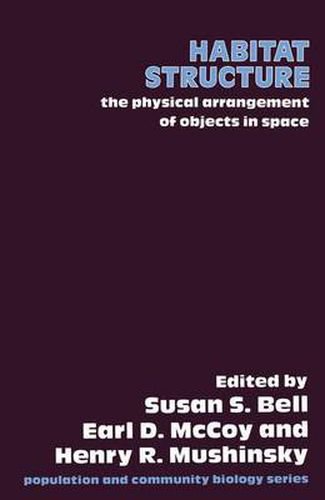Readings Newsletter
Become a Readings Member to make your shopping experience even easier.
Sign in or sign up for free!
You’re not far away from qualifying for FREE standard shipping within Australia
You’ve qualified for FREE standard shipping within Australia
The cart is loading…






This title is printed to order. This book may have been self-published. If so, we cannot guarantee the quality of the content. In the main most books will have gone through the editing process however some may not. We therefore suggest that you be aware of this before ordering this book. If in doubt check either the author or publisher’s details as we are unable to accept any returns unless they are faulty. Please contact us if you have any questions.
We conceived the idea for this book after teaching a graduate seminar on ‘Habitat Complexity’ at The University of South Florida. Discussions during the seminar led us to conclude that similar goals were to be found in studies of the topic that spanned the breadth of ecological research. Yet, the exact meaning of ‘habitat structure’, and the way in which it was measured, seemed to differ widely among subdisciplines. Our own research, which involves several sorts of ecology, convinced us that the differences among subdisciplines were indeed real ones, and that they did inhibit communica tion. We decided that interchange of ideas among researchers working in marine ecology, plant-animal interactions, physiological ecology, and other more-or-less independent fields would be worthwhile, in that it might lead to useful generalizations about ‘habitat structure’. To foster this interchange of ideas. we organized a symposium to attract researchers working with a wide variety of organisms living in many habitats, but united in their interest in the topic of ‘habitat structure’. The symposium was held at The University of South Florida’s Chinsegut Hill Conference Center, in May. 1988. We asked participants to think about ‘habitat structure’ in new ways; to synthesize important, but fragmented, information; and. perhaps. to consider ways of translating ideas across systems. The chapters contained in this book reflect the participants’ attempts to do so. The book is divided into four parts, by major themes that we have found useful categorizations.
$9.00 standard shipping within Australia
FREE standard shipping within Australia for orders over $100.00
Express & International shipping calculated at checkout
This title is printed to order. This book may have been self-published. If so, we cannot guarantee the quality of the content. In the main most books will have gone through the editing process however some may not. We therefore suggest that you be aware of this before ordering this book. If in doubt check either the author or publisher’s details as we are unable to accept any returns unless they are faulty. Please contact us if you have any questions.
We conceived the idea for this book after teaching a graduate seminar on ‘Habitat Complexity’ at The University of South Florida. Discussions during the seminar led us to conclude that similar goals were to be found in studies of the topic that spanned the breadth of ecological research. Yet, the exact meaning of ‘habitat structure’, and the way in which it was measured, seemed to differ widely among subdisciplines. Our own research, which involves several sorts of ecology, convinced us that the differences among subdisciplines were indeed real ones, and that they did inhibit communica tion. We decided that interchange of ideas among researchers working in marine ecology, plant-animal interactions, physiological ecology, and other more-or-less independent fields would be worthwhile, in that it might lead to useful generalizations about ‘habitat structure’. To foster this interchange of ideas. we organized a symposium to attract researchers working with a wide variety of organisms living in many habitats, but united in their interest in the topic of ‘habitat structure’. The symposium was held at The University of South Florida’s Chinsegut Hill Conference Center, in May. 1988. We asked participants to think about ‘habitat structure’ in new ways; to synthesize important, but fragmented, information; and. perhaps. to consider ways of translating ideas across systems. The chapters contained in this book reflect the participants’ attempts to do so. The book is divided into four parts, by major themes that we have found useful categorizations.